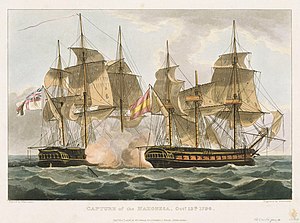| Action of 13 October 1796 | |||||||
|---|---|---|---|---|---|---|---|
| Part of the French Revolutionary Wars | |||||||
 Print by Thomas Whitcombe depicting HMS Terpsichore capturing the Mahonesa on 13 October 1796 | |||||||
| |||||||
| Belligerents | |||||||
|
|
| ||||||
| Commanders and leaders | |||||||
|
|
| ||||||
| Strength | |||||||
| 1 frigate | 1 frigate | ||||||
| Casualties and losses | |||||||
| 4 wounded |
30 killed 30 wounded 1 frigate captured 250 captured | ||||||
The action of 13 October 1796 was a minor naval engagement of the French Revolutionary Wars, fought off the Mediterranean coast of Spain near Cartagena between the British Royal Navy 32-gun frigate HMS Terpsichore under Captain Richard Bowen and the Spanish Navy 34-gun frigate Mahonesa under Captain Tomás de Ayalde. The action was the first battle of the Anglo-Spanish War, coming just eight days after the Spanish declaration of war. In a battle lasting an hour and forty minutes, Mahonesa was captured.
Spain had been an ally of Britain in the first years of the War of the First Coalition against the newly formed French Republic. Relations between the allies had often been strained, and following a series of defeats in the War of the Pyrenees the Spanish signed a peace treaty in August 1795. A year later the Treaty of San Ildefonso brought Spain back into the war, now as an ally of France. The war in the Mediterranean had reached a stalemate after two inconclusive battles in the spring of 1795, with a British blockade of the French naval base at Toulon maintained from San Fiorenzo and Leghorn under Vice-Admiral Sir John Jervis. The French dominance in the Italian campaign of 1796 made the British position tenuous, and with Spain's entry into the war Jervis was forced to disperse his limited forces further still, with forces watching Spanish shipping at Cádiz.
Off Cartagena Bowen commanded the small frigate Terpsichore, which had been shadowing a large Spanish fleet which had left Cádiz a few days earlier. As he returned to Gibraltar Bowen encountered Mahonesa, and the Spanish captain Ayalde offered battle. Bowen accepted and the ships fought an extended engagement at close quarters. The Spanish ship took much more serious damage and casualties than the British, and gradually the crew began to slip away from their guns. Ayalde made an attempt to escape, but his ship was too crippled and after a chase of 20 minutes he surrendered. Bowen brought the prize to Lisbon, where the damage was revealed to be too severe to repair. Bowen served in a number of engagements off Cádiz in the following months, until he was killed in July 1797 at the Battle of Santa Cruz.
